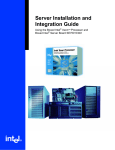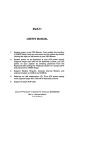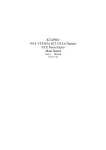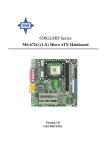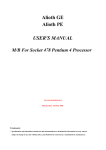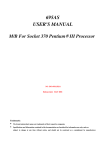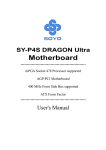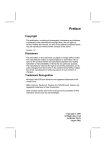Download 4S645 USER`S MANUAL
Transcript
4S645 USER'S MANUAL M/B For Socket 478 Pentium 4 Processor NO. G03-4S645R3A Release date: July 2002 Trademark: * Specifications and Information contained in this documentation are furnished for information use only, and are subject to change at any time without notice, and should not be construed as a commitment by manufacturer. TABLE OF CONTENT USER’S NOTICE ............................................................................... ii MANUAL REVISION INFORMATION............................................... 1 COOLING SOLUTIONS ................................................................... 1 CHAPTER 1 INTRODUCTION OF 4S645 MOTHERBOARD 1-1 1-2 1-3 1-4 FEATURE OF MOTHERBOARD............................................................... 2 SPECIFICATION .......................................................................................... 3 PERFORMANCE LIST ................................................................................ 4 LAYOUT DIAGRAM & JUMPER SETTING ........................................... 5 CHAPTER 2 HARDWARE INSTALLATION 2-1 HARDWARE INSTALLATION STEPS ..................................................... 7 2-2 CHECKING MOTHERBOARD'S JUMPER SETTING .......................... 7 2-3 INSTALL CPU ............................................................................................... 8 2-3-1 GLOSSARY....................................................................................................8 2-3-2 ABOUT INTEL PENTIUM 4 478-PIN CPU ........................................9 2-4 INSTALL MEMORY .................................................................................... 10 2-5 EXPANSION CARD ...................................................................................... 11 2-5-1 PROCEDURE FOR EXPANSION CARD INSTALLATION .................. 11 2-5-2 ASSIGNING IRQ FOR EXPANSION CARD ............................................ 11 2-5-3 INTERRUPT REQUEST TABLE FOR THIS MOTHERBOARD .......... 12 2-5-4 AGP SLOT ..................................................................................................... 12 2-6 CONNECTORS, HEADERS......................................................................... 12 2-6-1 CONNECTORS ............................................................................................. 12 2-6-2 HEADERS ...................................................................................................... 15 2-7 STARTING UP YOUR COMPUTER.......................................................... 19 CHAPTER 3 INTRODUCING BIOS 3-1 3-2 3-3 3-4 3-5 3-6 ENTERING SETUP....................................................................................... 20 GETTING HELP............................................................................................ 21 THE MAIN MENU ........................................................................................ 21 STANDARD CMOS FEATURES................................................................. 22 ADVANCED BIOS FEATURES .................................................................. 24 ADVANCED CHIPSET FEATURES .......................................................... 26 3-6-1 DRAM TIMING SETTINGS ............................................................ 27 3-6-2 AGP FUNCTION SETTINGS .......................................................... 28 3-7 INTEGRATED PERIPHERALS.................................................................. 28 3-7-1 ONCHIP IDE FUNCTION................................................................ 29 3-7-2 ONCHIP DEVICE FUNCTION ....................................................... 30 3-7-3 ONCHIP SUPERIO FUNCTION ..................................................... 31 3-8 POWER MANAGEMENT SETUP .............................................................. 32 3-8-1 PM WAKE UP EVENTS .................................................................. 33 3-9 PNP/PCI CONFIGURATION SETUP......................................................... 34 i 3-10 3-11 3-12 3-13 3-9-1 IRQ RESOURCES ............................................................................ 35 PC HEALTH STATUS ................................................................................. 35 MISCELLANEOUS CONTROL................................................................. 36 LOAD STANDARD/OPTIMIZED DEFAULTS ....................................... 37 SET SUPERVISOR/USER PASSWORD ................................................... 37 CHAPTER 4 DRIVER & FREE PROGRAM INSTALLATION MAGIC INSTALL SUPPORTS WINDOWS 95/98/98SE/NT4.0/2000.............. 38 4-1 AGPVXD INSTALL SIS AGPVXD DRIVER ........................................... 39 4-2 SOUND INSTALL ALC201 AUDIO CODEC DRIVER .......................... 40 4-3 PC-HEALTH WINBOND HARDWARE DOCTOR MONITORING SOFTWARE 41 USER’S NOTICE COPYRIGHT OF THIS MANUAL BELONGS TO THE MANUFACTURER. NO PART OF THIS MANUAL, INCLUDING THE PRODUCTS AND SOFTWARE DESCRIBED IN IT MAY BE REPRODUCED, TRANSMITTED OR TRANSLATED INTO ANY LANGUAGE IN ANY FORM OR BY ANY MEANS WITHOUT WRITTEN PERMISSION OF THE MANUFACTURER. THIS MANUAL CONTAINS ALL INFORMATION REQUIRED TO USE 4S645 MOTHERBOARD AND WE DO ASSURE THIS MANUAL MEETS USER’S REQUIREMENT BUT WILL CHANGE, CORRECT ANY TIME WITHOUT NOTICE. MANUFACTURER PROVIDES THIS MANUAL “AS IS” WITHOUT WARRANTY OF ANY KIND, AND WILL NOT BE LIABLE FOR ANY INDIRECT, SPECIAL, INCIDENTIAL OR CONSEQUENTIAL DAMAGES (INCLUDING DAMANGES FOR LOSS OF PROFIT, LOSS OF BUSINESS, LOSS OF USE OF DATA, INTERRUPTION OF BUSINESS AND THE LIKE). PRODUCTS AND CORPORATE NAMES APPEARING IN THIS MANUAL MAY OR MAY NOT BE REGISTERED TRADEMARKS OR COPYRIGHTS OF THEIR RESPECTIVE COMPANIES, AND THEY ARE USED ONLY FOR IDENTIFICATION OR EXPLANATION AND TO THE OWNER’S BENEFIT, WITHOUT INTENT TO INFRINGE. ii Manual Revision Information Reversion 3.0 Revision History Third Edition Date July 2002 Item Checklist 4S645 motherboard Cable for IDE/Floppy CD for motherboard utilities □ Cable for USB Port 3/4 (Option) 4S645 User’s Manual Intel Pentium 4 Processor Family Cooling Solutions As processor technology pushes to faster speeds and higher performance, thermal management becomes increasingly crucial when building computer systems. Maintaining the proper thermal environment is key to reliable, long-term system operation. The overall goal in providing the proper thermal environment is keeping the processor below its specified maximum case temperature. Heatsinks induce improved processor heat dissipation through increased surface area and concentrated airflow from attached fans. In addition, interface materials allow effective transfers of heat from the processor to the heatsink. For optimum heat transfer, Intel recommends the use of thermal grease and mounting clips to attach the heatsink to the processor. When selecting a thermal solution for your system, please refer to the website below for collection of heatsinks evaluated and recommended by Intel for use with Intel processors. Note, those heatsinks are recommended for maintaining the specified Maximum T case requirement. In addition, this collection is not intended to be a comprehensive listing of all heatsinks that support Intel processors. For vendor list of heatsink and fan, please visit : http://developer.intel.com/design/Pentium4/components/index 1 Chapter 1 Introduction of 4S645 Motherboard 1-1 Feature of motherboard The 4S645 motherboard is design for use Intel Pentium 4 Processor in 478 Pin Package/Northwood Processor with the SiS 645 Chipset delivers a high performance and professional desktop platform solution. Which utilize the Socket 478 design and the memory size expandable to 3.0GB. This motherboard use the newest SiS 645 Chipset Supports 400MHz System Bus in data transfer rate and 100MHz/133MHz/166MHz SDRAM clock frequency support DDR200/DDR266/DDR333 DDR SDRAM Module . The 4S645 motherboard offers ULTRA ATA 100 to provide speedier HDD throughout that boosts overall system performance. The motherboard also has an integrated AC’97 2.1 CODEC on board which is fully compatible with Sound Blaster Pro that gives you the best sound quality and compatibility. For those wanting even greater graphic performance, an AGP 4X slot is included on the board. With USB control as well as capability of expanding to 4 USB function ports, the 4S645 meet future USB demand also this motherboard has built-in hardware monitor function to monitor and protect your computer. This motherboard can conditional support traditional ATX Power Supply, if the 12V output of Power Supply can offer more than 120W, let you have more choice when use Power Supply. We use three phase design in CPU Vcore Voltage let CPU Voltage more stable when CPU full speed running. By Magic Install CD, users can install system drivers easily and friendly, and the Magic BIOS Utility can offer BIOS live update from web, auto detected BIOS version to prevent update wrong BIOS. In 4S645, we have CPU Host clock step-by-step increment designs in BIOS Setup Utility to increasing CPU Host Clock let users approach over clock demand. 4S645 provides high performance & meets future specification demand. It is really wise choice for your computer. 2 1-2 Specification Spec Design Chipset CPU Socket (mPGA478B Socket) Memory Socket Expansion Slot & Headers Integrate IDE Audio BIOS Multi I/O Description ∗ ∗ ∗ ∗ ∗ ∗ ∗ ∗ ∗ ∗ ∗ ∗ ∗ ∗ ∗ ∗ ∗ ∗ ∗ ∗ ∗ ∗ ∗ ∗ ATX form factor 4 layers PCB size: 30.5x21.0cm SiS 645 North Bridge Chipset SiS 961 HyperZip Media I/O Chipset Support Intel Pentium 4 478 Pin package utilizes FlipChip Pin Grid Array (FC-PGA2) package processor Support 1.5G∼2.2G 478 Pin Pentium 4 processor Reserves support for future Intel Pentium 4 processors 184-pin DDR SDRAM module socket x3 Support 2 pcs DDR333 or 3 pcs DDR200/DDR266 DDR SDRAM Modules Expandable to 3.0GB AGP slot x1 support AGP 2.0 & 4X mode 32-bit PCI slot x5 CNR slot x1 Two PCI IDE controllers support PCI Bus Mastering, ATA PIO/DMA and the ULTRA DMA 33/66/100 functions that deliver the data transfer rate up to 100 MB/s AC’97 Digital Audio controller integrated AC’97 Audio CODEC on board Audio driver and utility included Award 2MB Flash ROM PS/2 keyboard and PS/2 mouse connectors Floppy disk drive connector x1 Parallel port x1 Serial port x2 USB connector x2 USB headers x2 (connecting cable option) Audio connector (Line-in, Line-out , MIC & Game Port) 3 1-3 Performance List The following performance data list is the testing result of some popular benchmark testing programs. These data are just referred by users, and there is no responsibility for different testing data values gotten by users (the different Hardware & Software configuration will result in different benchmark testing results.) Performance Test Report Intel Pentium 4 1.9GHz mPGAB package 128M DDR266 x2 (SAMSUNG K4H280838B-TCB0) 256M DDR333 x1 (KINGMAX KDL684T4A2A-6) VGA Expansion Card: NVDIA Geforce2 MX-400 64MB (1024x768xHi-color) IBM DTLA-305040 (ATA-100) Hard Disk Driver: Award Optimal default BIOS: Win 98SE OS: CPU: DRAM: Performance Test Report DDR266 5369 2492 103 9.76 42.5 52.7 45.1 DDR333 5477 2519 104 10.60 43.6 53.6 46.7 3D Mark 2000 3D Mark 2001 3D Winbench 2000 Final Reality Content Creation Winstone 2000 Content Creation Winstone 2001 Business Winstone2001 Winbench 99: CPU Mark 99 109 114 FPU Winmark 99 6600 6610 Business Disk Winmark99 7650 8980 Hi-end Disk Winmark99 19000 20400 Business Graphic Winmark 432 440 Hi-end Graphic Winmark 1250 1270 SYS Mark 2001 : SISMark 2000/2001 Rating (Internet Content Creation / Office Productivity) SISMark 2000 205 (223/192) 214 (233/201) SISMark 2001 149 (167/133) 154 (174/136) SISOFT Sandra 2001 : Dhrystone ALU MIPS 3623 3616 Whetstone FPU MFLOPS 1136/2365 1131/2369 Int ALU/RAM MB/S 881 1098 Float FPU/RAM MB/S 892 1117 Integer SSE2 IT/S 7531 7538 Floating-Point SSE2 IT/S 9342 9333 QUAKE3 DEMO1 FPS 164.6 176.6 DEMO2 FPS 164.9 178.7 WCPUID System/CPU Clock 100.67/1912.81 100.67/1912.81 4 5 1-4 Layout Diagram & Jumper Setting PRINT GAME/MIDI PORT PS/2 MOUSE PS/2 Keyboard USB COM1 COM2 K/B Power ON Jumper (JP1) MIC LINE-IN LINE-OUT CPU Socket PS2 KB/Mouse Port CPU FAN USB Port PC99 Back Panel DDR DIMMX3 SiS 645 Chip ATX 12V Power Conn. ATX Power Connector SYSTEM FAN Front Panel Audio AGP Slot ITE 8705 Chip CD Audio SiS 961 Chip 2MBit Flash ROM BIOS ATA 100 IDE Conn. PCI Slot Clear CMOS (JP2) Floppy Connector Front Panel Connector CNR Slot Wake On LAN IR Connector USB Port 6 Jumpers Jumper JP2 JP1 Name Description CMOS RAM Clear Page 3-pin Block P.7 Keyboard Power On Enable/Disabled 3-pin Block P.8 Connectors Connector Name Description Page ATX1 ATX2 KBMS1 ATX Power Connector 20-pin Block P.12 ATX 12V Power Connector 4-pin Block P.13 PS/2 Mouse & PS/2 Keyboard Connector 6-pin Female P.13 USB1 PRINT1 USB Port Connector 4-pin Connector P.13 Parallel Port Connector 25-pin Female P.13 AUDI_GAME Audio/Game Connector 3 phone jack + 15-pin Connector P.13 9-pin Connector P.14 34-pin Block P.14 40-pin Block P.14 COM1/COM2 Serial Port COM1/2 Connector FDC1 Floppy Driver Connector IDE1/IDE2 Primary/Secondary IDE Connector Headers Header Name Description Page FAUDIO USB2 HDLED RESET SPK2 ACPILED PWRBT WOL1 SPEAKER, MIC header 9-pin Block P.15 USB Port Headers 9-pin Block P.16 IDE activity LED 2-pin Block P.16 Reset switch lead 2-pin Block P.16 PC Speaker connector 4-pin Block P.16 Power LED 2-pin Block P.16 Power switch 2-pin Block P.16 Wake On-LAN Headers 3-pin Block P.17 SYSTEM FAN, CPU FAN FAN Speed Headers 3-pin Block P.17 IR1 CDIN1 IR infrared module Headers 5-pin Block P.17 CD Audio-In Headers 4-pin Block P.18 Expansion Sockets Socket/Slot Name Description Page ZIF Socket 478 DIMM1, DIMM2, DIMM3 CPU Socket 478-pin mPGAB CPU Socket P.9 SDRAM Module Socket 184-pin DDR SDRAM Module Expansion Socket P.10 PCI1 ∼ PCI5 AGP CNR PCI Slot 32-bit PCI Local Bus Expansion slots P.11 AGP 4X Mode Slot AGP Expansion Slot CNR Slot Communication Network Riser Slot 7 P.12 Chapter 2 Hardware installation 2-1 Hardware installation Steps Before using your computer, you had better complete the following steps: 1. Check motherboard jumper setting 2. Install CPU and Fan 3. Install System Memory (DIMM) 4. Install Expansion cards 5. Connect IDE and Floppy cables, Front Panel /Back Panel cable 6. Connect ATX Power cable 7. Power-On and Load Standard Default 8. Reboot 9. Install Operating System 10. Install Driver and Utility 2-2 Checking Motherboard’s Jumper Setting (1) CMOS RAM Clear (3-pin) : JP2 A battery must be used to retain the motherboard configuration in CMOS RAM short 2-3 pins of JP2 to store the CMOS data. To clear the CMOS, follow the procedure below: 1. Turn off the system and unplug the AC power 2. Remove ATX power cable from ATX power connector 3. Locate JP2 and short pins 1-2 for a few seconds 4. Return JP2 to its normal setting by shorting pins 2-3 5. Connect ATX power cable back to ATX power connector Note: When should clear CMOS 1. Troubleshooting 2. Forget password 3. After over clocking system boot fail 1 1 3 JP2 3 JP2 1-2 closed Clear CMOS 2-3 closed CMOS RAM Clear Setting 8 Normal (Default) (2) Keyboard Power On function Enabled/Disabled: JP1 When setting Enabled you can using keyboard by key in password to power on system. 1 1 3 JP1 1-2 closed (Default) 3 JP1 K/B Power ON Disable 2-3 closed K/B Power ON Enabled Keyboard Power On Setting 2-3 Install CPU 2-3-1 Glossary Chipset (or core logic) - two or more integrated circuits which control the interfaces between the system processor, RAM, I/O devises, and adapter cards. Processor slot/socket - the slot or socket used to mount the system processor on the motherboard. Slot (AGP, PCI, ISA, RAM) - the slots used to mount adapter cards and system RAM. AGP - Accelerated Graphics Port - a high speed interface for video cards; runs at 1X (66MHz), 2X (133MHz), or 4X (266MHz). PCI - Peripheral Component Interconnect - a high speed interface for video cards, sound cards, network interface cards, and modems; runs at 33MHz. ISA - Industry Standard Architecture - a relatively low speed interface primarily used for sound cards and modems; runs at approx. 8MHz. Serial Port - a low speed interface typically used for mouse and external modems. Parallel Port - a low speed interface typically used for printers. PS/2 - a low speed interface used for mouse and keyboards. USB - Universal Serial Bus - a medium speed interface typically used for mouse, keyboards, scanners, scanners, and some digital cameras. Sound (interface) - the interface between the sound card or integrated sound connectors and speakers, MIC, game controllers, and MIDI sound devices. LAN (interface) - Local Area Network - the interface to your local area network. BIOS (Basic Input/Output System) - the program logic used to boot up a computer and establish the relationship between the various components. Driver - software, which defines the characteristics of a device for use by another device or other software. 9 Processor - the "central processing unit" (CPU); the principal integrated circuit used for doing the "computing" in "personal computer" Front Side Bus Frequency - the working frequency of the motherboard, which is generated by the clock generator for CPU, DRAM and PCI BUS. CPU L2 Cache - the flash memory inside the CPU, normal it depend on CPU type 2-3-2 About Intel Pentium 4 478-pin CPU This motherboard provides a 478-pin surface mount, Zero Insertion Force (ZIF) socket, referred to as the mPGA478B socket supports Intel Pentium 4 processor in the 478 Pin package utilizes Flip-Chip Pin Grid Array (FC-PGA2) package technology. The CPU that comes with the motherboard should have a cooling FAN attached to prevent overheating. If this is not the case, then purchase a correct cooling FAN before you turn on your system. WARNING! Be sure that there is sufficient air circulation across the processor’s heatsink and CPU cooling FAN is working correctly, otherwise it may cause the processor and motherboard overheat and damage, you may install an auxiliary cooling FAN, if necessary. To install a CPU, first turn off your system and remove its cover. Locate the ZIF socket and open it by first pulling the level sideways away from the socket then upward to a 90-degree angle. Insert the CPU with the correct orientation as shown below. The notched corner should point toward the end of the level. Because the CPU has a corner pin for two of the four corners, the CPU will only fit in the orientation as shown. mPGA478B Colden Arrow CPU ZIF mPGAB Socket When you put the CPU into the ZIF socket. No force require to insert of the CPU, then press the level to Locate position slightly without any extra force. 10 2-4 Install Memory This motherboard provides three 184-pin DUAL INLINE MEMORY MODULES (DIMM) sites for DDR memory expansion available from minimum memory size of 64MB to maximum memory size of 3.0GB DDR SDRAM. Valid Memory Configurations Bank 184-Pin DIMM Total Memory Bank 0, 1 (DIMM1) DDR200/DDR266/DDR333 DDR SDRAM Module X1 64MB∼1.0GB Bank 2, 3 (DIMM2) DDR200/DDR266/DDR333 DDR SDRAM Module X1 64MB∼1.0GB Bank 4, 5 (DIMM3) DDR200/DDR266 DDR SDRAM Module X1 64MB∼1.0GB 3 64MB∼3.0GB Total System Memory (Max. 3.0GB) NOTE! Due to SiS 645 chip specification limited it only can support 2 pcs DDR333 module when DDR clock setting in 166MHz. DIMM3 (BANK4+BANK5) DIMM2 (BANK2+BANK3) DIMM1 (BANK0+BANK1) Generally, installing DDR SDRAM modules to your motherboard is very easy, you can refer to figure 2-4 to see what a 184-Pin DDR SDRAM module looks like. Figure 2-4 NOTE! When you install DIMM module fully into the DIMM socket the eject tab should be locked into the DIMM module very firmly and fit into its indention on both sides. WARNING! For the DDR SDRAM CLOCK is set at 133MHz, use only DDR266compliant DDR Modules. When this motherboard operate at 133Mhz, most system will not even boot if non-compliant modules are used because of the strict timing issues, if your DDR Modules are not DDR266-compliant, set the SDRAM clock to 100MHz to ensure system stability. 11 2-5 Expansion Cards WARNING! Turn off your power when adding or removing expansion cards or other system components. Failure to do so may cause severe damage to both your motherboard and expansion cards. 2-5-1 Procedure For Expansion Card Installation 1. Read the documentation for your expansion card and make any necessary hardware or software setting for your expansion card such as jumpers. 2. Remove your computer’s cover and the bracket plate on the slot you intend to use. 3. Align the card’s connectors and press firmly. 4. Secure the card on the slot with the screen you remove above. 5. Replace the computer system’s cover. 6. Set up the BIOS if necessary. 7. Install the necessary software driver for your expansion card. 2-5-2 Assigning IRQs For Expansion Card Some expansion cards need an IRQ to operate. Generally, an IRQ must exclusively assign to one use. In a standard design, there are 16 IRQs available but most of them are already in use. Standard Interrupt Assignments IRQ 0 1 2 3* 4* 5* 6* 7* 8 9* 10 * 11 * 12 * 13 14 * 15 * Priority N/A N/A N/A 8 9 6 11 7 N/A 10 3 2 4 N/A 5 1 Standard function System Timer Keyboard Controller Programmable Interrupt Communications Port (COM2) Communications Port (COM1) Sound Card (sometimes LPT2) Floppy Disk Controller Printer Port (LPT1) System CMOS/Real Time Clock ACPI Mode when enabled IRQ Holder for PCI Steering IRQ Holder for PCI Steering PS/2 Compatible Mouse Port Numeric Data Processor Primary IDE Channel Secondary IDE Channel * These IRQs are usually available for ISA or PCI devices. 2-5-3 Interrupt Request Table For This Motherboard 12 Interrupt request are shared as shown the table below: Slot 1 Slot 2 Slot 3 Slot 4 Slot 5 Onboard USB 1 Onboard USB 2 AC97/MC97 PROMISE INT A INT B INT C INT D INT E √ √ √ √ INT F INT G INT H √ √ √ √ IMPORTANT! If using PCI cards on shared slots, make sure that the drivers support “Shared IRQ” or that the cards don’t need IRQ assignments. Conflicts will arise between the two PCI groups that will make the system unstable or cards inoperable. 2-5-4 AGP Slot This motherboard provides an AGP Slot, support the 1X/2X/4X AGP VGA card. 2x notch 4x notch AGP SLOT 2-6 Connectors, Headers 2-6-1 Connectors (1) Power Connector (20-pin block) : ATX1 ATX Power Supply connector. This is a new defined 20-pins connector that usually comes with ATX case. The ATX Power Supply allows to use soft power on momentary switch that connect from the front panel switch to 2-pins Power On jumper pole on the motherboard. When the power switch on the back of the ATX power supply turned on, the full power will not come into the system board until the front panel switch is momentarily pressed. Press this switch again will turn off the power to the system board. 13 Pin 1 PIN ROW2 ROW1 1 2 3 4 5 6 7 8 9 10 3.3V -12V GND Soft Power On GND GND GND -5V +5V +5V 3.3V 3.3V GND 5V GND 5V GND Power OK +5V (for Soft Logic) +12V (2) ATX 12V Power Connector (4-pin block) : ATX2 This is a new defined 4-pin connector that usually comes with ATX Power Supply. The ATX Power Supply which fully support Pentium 4 processor must including this connector for support extra 12V voltage to maintain system power consumption. Without this connector might cause system unstable because the power supply can not provide sufficient current for system. This Motherboard Conditional supports the ATX Power Supply which without Extra ATX 12V Power connector, if it’s 12V output can offer more than 120W to maintain system power consumption. GND +12V ∗ GND +12V Pin 1 (3) PS/2 Mouse & PS/2 Keyboard Connector: KBMS1 The connectors for PS/2 keyboard and PS/2 Mouse. (4) USB Port connector: USB1 The connectors are 4-pin connector that connect USB devices to the system board. (5) Parallel Port Connector (25-pin female): PRINT1 Parallel Port connector is a 25-pin D-Subminiature Receptacle connector. The Onboard Parallel Port can be disabled through the BIOS SETUP. Please refer to Chapter 3 “INTEGRATED PERIPHERALS SETUP” section for more detail information. (6) Audio and Game Connector : AUDIO_GAME (SPK1, LININ1, MIC1, GAME1) This Connector are 3 phone Jack for LINE-OUT, LINE-IN, MIC and a 15-pin D-Subminiature Receptacle Connector for joystick/MIDI Device. Audio output to speaker Line-out : Audio input to sound chip Line-in : Microphone Connector MIC : Game/MIDI : For joystick or MIDI Device 14 (7) Serial Port COM1, COM2 : COM1, COM2 COM1, COM2 are the 9-pin D-Subminiature mail connector. The On-board serial port can be disabled through BIOS SETUP. Please refer to Chapter 3 “INTEGRATED PERIPHERALS SETUP” section for more detail information. PS/2 MOUSE PRINT PS/2 USB Keyboard (8) COM1 GAME/MIDI PORT COM2 MIC LINE-IN LINE-OUT Floppy drive Connector (34-pin block): FDC1 This connector supports the provided floppy drive ribbon cable. After connecting the single plug end to motherboard, connect the two plugs at other end to the floppy drives. Pin 1 Floppy Drive Connector (9) Primary IDE Connector (40-pin block): IDE1 This connector supports the provided IDE hard disk ribbon cable. After connecting the single plug end to motherboard, connect the two plugs at other end to your hard disk(s). If you install two hard disks, you must configure the second drive to Slave mode by setting its jumpers accordingly. Please refer to the documentation of your hard disk for the jumper settings. 15 Pin 1 Primary IDE Connector (10) Secondary IDE Connector (40-pin block): IDE2 This connector connects to the next set of Master and Slave hard disks. Follow the same procedure described for the primary IDE connector. You may also configure two hard disks to be both Masters using one ribbon cable on the primary IDE connector and another ribbon cable on the secondary IDE connector. Pin 1 Secondary IDE Connector • Two hard disks can be connected to each connector. The first HDD is referred to as the “Master” and the second HDD is referred to as the “Slave”. • For performance issues, we strongly suggest you don’t install a CD-ROM or DVD-ROM drive on the same IDE channel as a hard disk. Otherwise, the system performance on this channel may drop. 2-6-2 Headers (1) Line-Out/MIC Header for Front Panel (9-pin): FAUDIO This header connect to Front Panel Line-out, MIC connector with cable. Without install the cable, this header default setting is 5-6 short, 9-10 short. When you install the cable you have take off these jumpers. 16 AUD_RET_L AUD_GND AUD_VCC AUD_RET_R FAUDIO 2 10 Pin 1 AUD_MIC AUD_MIC_BIAS AUD_FPOUT_R HP_ON AUD_FPOUT_L 9 Line-Out, MIC Headers -DATA +DATA GND OC -DATA +DATA GND USB2 VCC USB Port Headers (9-pin) : USB2 These headers are used for connecting the additional USB port plug. By attaching an option USB cable, your can be provided with two additional USB plugs affixed to the back panel. VCC (2) OC (Over Current) Pin 1 USB Port Headers (3) (4) (5) (6) (7) IDE Activity LED: HDLED This connector connects to the hard disk activity indicator light on the case. Reset switch lead: RESET This 2-pin connector connects to the case-mounted reset switch for rebooting your computer without having to turn off your power switch. This is a preferred method of rebooting in order to prolong the lift of the system’s power supply. See the figure below. Speaker connector: SPK2 This 4-pin connector connects to the case-mounted speaker. See the figure below. Power LED: ACPILED The Power LED is light on while the system power is on. Connect the Power LED from the system case to this pin. Power switch: PWRBT This 2-pin connector connects to the case-mounted power switch to power ON/OFF the system. 17 PWRBT ACPILED FP1 VCC5 ACPILED PWRBTN GND SPK2 RESET VCC5 HDDLED GND RSTSW NC Pin 1 HDLED SPKR NC GND VCC5 Pin 1 System Case Connections (8) Wake On-LAN Headers (3-pin) : WOL1 This connector connects to a LAN card with a WAKE ON-LAN output. This connector power up the system when a wake up signal is received through the LAN/Modem card. 5VSB GND WON NOTE: This feature requires that Wake On LAN or Ring In Wake up is enabled. WOL1 1 3 Wake-On-LAN Headers (9) FAN Speed Headers (3-pin) : SYSTEM FAN, CPU FAN These connectors support cooling fans of 350mA (4.2 Watts) or less, depending on the fan manufacturer, the wire and plug may be different. The red wire should be positive, while the black should be ground. Connect the fan’s plug to the board taking into consideration the polarity of connector. 18 CPU FAN 1 3 1 SYSTEM FAN 3 (10) IR infrared module Headers (5-pin) : IR1 This connector supports the optional wireless transmitting and receiving infrared module. You must configure the setting through the BIOS setup to use the IR function. GND IRRX IR1 2 6 Pin 1 NC VCC5 IRTX 5 IR infrared module Headers (11) CD Audio-In Headers (4-pin) : CDIN1 CDIN are the connectors for CD-Audio Input signal. Please connect it to CD-ROM CD-Audio output connector. CDIN1 1 4 CD Audio-In Headers 19 2-7 Starting Up Your Computer 1. After all connection are made, close your computer case cover. 2. Be sure all the switch are off, and check that the power supply input voltage is set to proper position, usually in-put voltage is 220V∼240V or 110V∼120V depending on your country’s voltage used. 3. Connect the power supply cord into the power supply located on the back of your system case according to your system user’s manual. 4. Turn on your peripheral as following order: a. Your monitor. b. Other external peripheral (Printer, Scanner, External Modem etc…) c. Your system power. For ATX power supplies, you need to turn on the power supply and press the ATX power switch on the front side of the case. 5. The power LED on the front panel of the system case will light. The LED on the monitor may light up or switch between orange and green after the system is on. If it complies with green standards or if it is has a power standby feature. The system will then run power-on test. While the test are running, the BIOS will alarm beeps or additional message will appear on the screen. If you do not see any thing within 30 seconds from the time you turn on the power. The system may have failed on power-on test. Recheck your jumper settings and connections or call your retailer for assistance. Beep Meaning One short beep when displaying logo No error during POST Long beeps in an endless loop No DRAM install or detected One long beep followed by three short beeps Video card not found or video card memory bad High frequency beeps when system is working CPU overheated System running at a lower frequency 6. During power-on, press <Delete> key to enter BIOS setup. Follow the instructions in BIOS SETUP. 7. Power off your computer: You must first exit or shut down your operating system before switch off the power switch. For ATX power supply, you can press ATX power switching after exiting or shutting down your operating system. If you use Windows 9X, click “Start” button, click “Shut down” and then click “Shut down the computer?” The power supply should turn off after windows shut down. 20 Chapter 3 Introducing BIOS The BIOS is a program located on a Flash Memory on the motherboard. This program is a bridge between motherboard and operating system. When you start the computer, the BIOS program gain control. The BIOS first operates an auto-diagnostic test called POST (power on self test) for all the necessary hardware, it detects the entire hardware device and configures the parameters of the hardware synchronization. Only when these tasks are completed done it gives up control of the computer to operating system (OS). Since the BIOS is the only channel for hardware and software to communicate, it is the key factor for system stability, and in ensuring that your system performance as its best. In the BIOS Setup main menu of Figure 3-1, you can see several options. We will explain these options step by step in the following pages of this chapter, but let us first see a short description of the function keys you may use here: • Press <Esc> to quit the BIOS Setup. • Press ↑ ↓ ← → (up, down, left, right) to choose, in the main menu, the option you want to confirm or to modify. • Press <F10> when you have completed the setup of BIOS parameters to save these parameters and to exit the BIOS Setup menu. • Press Page Up/Page Down or +/– keys when you want to modify the BIOS parameters for the active option. 3-1 Entering Setup Power on the computer and by pressing <Del> immediately allows you to enter Setup. If the message disappears before your respond and you still wish to enter Setup, restart the system to try again by turning it OFF then ON or pressing the “RESET” button on the system case. You may also restart by simultaneously pressing <Ctrl>, <Alt> and <Delete> keys. If you do not press the keys at the correct time and the system does not boot, an error message will be displayed and you will again be asked to Press <F1> to continue, <Ctrl-Alt-Esc> or <Del> to enter Setup 21 3-2 Getting Help Main Menu The on-line description of the highlighted setup function is displayed at the bottom of the screen. Status Page Setup Menu/Option Page Setup Menu Press F1 to pop up a small help window that describes the appropriate keys to use and the possible selections for the highlighted item. To exit the Help Window, press <Esc>. 3-3 The Main Menu Once you enter Award BIOS CMOS Setup Utility, the Main Menu (Figure 3-1) will appear on the screen. The Main Menu allows you to select from fourteen setup functions and two exit choices. Use arrow keys to select among the items and press <Enter> to accept or enter the sub-menu. CMOS Setup Utility – Copyright(C) 1984-2001 Award Software Standard CMOS Features Miscellaneous Control Advanced BIOS Features Load optimized Defaults Advanced Chipset Features Load Standard Defaults Integrated Peripherals Set Supervisor Password Power Management Setup Set User Password PnP/PCI Configurations Save & Exit Setup PC Health Status Exit Without Saving Esc : Quit F10 : Save & Exit Setup ↑↓→ ← : Select Item Time, Date, Hard Disk Type... Figure 3-1 Standard CMOS Features Use this Menu for basic system configurations. Advanced BIOS Features Use this menu to set the Advanced Features available on your system. Advanced Chipset Features Use this menu to change the values in the chipset registers and optimize your system’s performance. 22 Integrated Peripherals Use this menu to specify your settings for integrated peripherals. Power Management Setup Use this menu to specify your settings for power management. PnP/PCI configurations This entry appears if your system supports PnP/PCI. PC Health Status This entry shows your PC health status. Miscellaneous Control Use this menu to specify your settings for Miscellaneous control. Load Optimized Defaults Use this menu to load the BIOS default values that are factory settings for optimal performances system operations. Load Standard Defaults Use this menu to load the BIOS default values for the minimal/stable performance system operation. Set Supervisor/User Password Use this menu to set User and Supervisor Passwords. Save & Exit Setup Save CMOS value changes to CMOS and exit setup. Exit Without Saving Abandon all CMOS value changes and exit setup. 3-4 Standard CMOS Features The items in Standard CMOS Setup Menu are divided into several categories. Each category includes no, one or more than one setup items. Use the arrow keys to highlight the item and then use the <PgUp> or <PgDn> keys to select the value you want in each item. 23 CMOS Setup Utility – Copyright(C) 1984-2001 Award Software Standard CMOS Features > > > > Date (mm:dd:yy) Time (hh:mm:ss) Mon, Oct, 26 2001 16 : 48 : 35 IDE IDE IDE IDE Press Press Press Press Primary Master Primary Slave Secondary Master Secondary Slave Enter Enter Enter Enter None None None None Drive A Drive B 1.44M, 3.25 in. None Video Halt On EGA/VGA All,But Keyboard Base Memory Extended Memory Total Memory Item Help Menu Level > Change the day, month, year and century 640K 56320K 57344K ↑↓→← Move Enter:Select +/-/PU/PD:Value F10:Save ESC:Exit F5:Previous Values F6:Optimized Defaults F1:General Help F7:Standard Defaults Date The date format is <day><month><date><year>. Day of the week, from Sun to Sat, determined by BIOS. Read-only. Day Month The month from Jan. through Dec. Date The date from 1 to 31 can be keyed by numeric function keys. Year The year depends on the year of the BIOS. Time The time format is <hour><minute><second>. Primary Master/Primary Slave Secondary Master/Secondary Slave Press PgUp/<+> or PgDn/<–> to select Manual, None, Auto type. Note that the specifications of your drive must match with the drive table. The hard disk will not work properly if you enter improper information for this category. If your hard disk drive type is not matched or listed, you can use Manual to define your own drive type manually. If you select Manual, related information is asked to be entered to the following items. Enter the information directly from the keyboard. This information should be provided in the documentation from your hard disk vendor or the system manufacturer. If the controller of HDD interface is SCSI, the selection shall be “None”. If the controller of HDD interface is CD-ROM, the selection shall be “None” Access Mode The settings are Auto Normal, Large, and LBA. number of cylinders Cylinder number of heads Head write precomp Precomp Landing Zone landing zone number of sectors Sector 24 3-5 Advanced BIOS Features CMOS Setup Utility – Copyright(C) 1984-2001 Award Software Advanced BIOS Features Anti-Virus Protection CPU L1 & L2 Cache CPU L2 Cache ECC Checking Quick Power On Self Test First Boot Device Second Boot Device Third Boot Device Boot Other Device Swap Floppy Drive Boot Up Floppy Seek Boot Up NumLock Status Gate A20 Option Typematic Rate Setting Typematic Rate (Chars/Sec) Typematic Delay (Msec) Security Option OS Select For DRAM > 64MB HDD S.M.A.R.T. Capability Report No FDD For Windows Video BIOS Shadow ↑↓→← Move Enter:Select F5:Previous Values Disabled Enabled Disabled Enabled Floppy HDD-0 CDROM Enabled Disabled Enabled On Fast Disabled 6 250 Setup Non-OS2 Disabled Yes Enabled Item Help Menu Level > Allows you to choose the VIRUS warning feature for IDE Hard Disk boot sector protection. If this function is enabled and someone attempt to write data into this area, BIOS will show a warning message on screen and alarm beep Enabled copies Video BIOS to shadow RAM Improves performance +/-/PU/PD:Value F10:Save ESC:Exit F6:Optimized Defaults F1:General Help F7:Standard Defaults Anti-Virus Protection Allows you to choose the VIRUS Warning feature for IDE Hard Disk boot sector protection. If this function is enabled and someone attempt to write data into this area, BIOS will show a warning message on screen and alarm beep. Disabled (default) No warning message to appear when anything attempts to access the boot sector or hard disk partition table. Activates automatically when the system boots up causing a warning Enabled message to appear when anything attempts to access the boot sector of hard disk partition table. CPU L1 Cache The default value is Enabled. Enabled (default) Enable cache Disable cache Disabled Note: The internal cache is built in the processor. CPU L2 Cache Choose Enabled or Disabled. This option enables the Level 2 cache memory. Quick Power On Self Test This category speeds up Power On Self Test (POST) after you power on the computer. If this is set to Enabled. BIOS will shorten or skip some check items during POST. Enabled (default) Enable quick POST Normal POST Disabled 25 First/Second/Third/ Boot Device, Boot Other Device The BIOS attempts to load the operating system from the devices in the sequence selected in these items. The settings are Floppy, LS/ZIP, HDD-0/HDD-1/HDD-3, SCSI, CDROM, LAN and Disabled. Swap Floppy Drive Switches the floppy disk drives between being designated as A and B. Default is Disabled. Boot Up Floppy Seek During POST, BIOS will determine if the floppy disk drive installed is 40 or 80 tracks. 360K type is 40 tracks while 760K, 1.2M and 1.44M are all 80 tracks. Boot Up NumLock Status The default value is On. On (default) Keypad is numeric keys. Keypad is arrow keys. Off Gate A20 Option The A20 signal is controlled by keyboard controller or chipset hardware. Normal Fast (default) The A20 signal is controlled by port 92 or chipset specific method. Typematic Rate Setting Keystrokes repeat at a rate determined by the keyboard controller. When enabled, the typematic rate and typematic delay can be selected. The settings are: Enabled/Disabled. Typematic Rate (Chars/Sec) Sets the number of times a second to repeat a keystroke when you hold the key down. The settings are: 6, 8, 10, 12, 15, 20, 24, and 30. Typematic Delay (Msec) Sets the delay time after the key is held down before is begins to repeat the keystroke. The settings are 250, 500, 750, and 1000. Security Option This category allows you to limit access to the system and Setup, or just to Setup. The system will not boot and access to Setup will be denied if the System correct password is not entered at the prompt. Setup (default) The system will boot, but access to Setup will be denied if the correct password is not entered prompt. OS Select For DRAM > 64MB Allows OS2 to be used with >64MB or DRAM. Settings are Non-OS/2 (default) and OS2. Set to OS/2 if using more than 64MB and running OS/2. Report No FDD For Win 95 Whether report no FDD for Win 95 or not. The settings are: Yes, No. 26 3-6 Advanced Chipset Features The Advanced Chipset Features Setup option is used to change the values of the chipset registers. These registers control most of the system options in the computer. CMOS Setup Utility – Copyright(C) 1984-2001 Award Software Advanced Chipset Features > DRAM Timing Settings > AGP Function Settings Prefetch Caching Memory Hole at 15M-16M ↑↓→← Move Enter:Select F5:Previous Values Press Enter Press Enter Disabled Disabled Item Help Menu Level > +/-/PU/PD:Value F10:Save ESC:Exit F1:General Help F6:Optimized Defaults F7:Standard Defaults DRAM Timing Settings Please refer to section 3-6-1 AGP Function Settings This option determines the effective size of the graphics aperture used in the particular PAC configuration. The AGP aperture is memory-mapped, while graphics data structure can reside in a graphics aperture. The aperture range should be programmed as not cacheable in the processor cache, accesses with the aperture range are forwarded to the main memory, then PAC will translate the original issued address via a translation table that is maintained on the main memory. The option allows the selection of an aperture size of 32MB, 64MB. Please refer to section 3-6-2 Memory Hole at 15M-16M You can reserve this area of system memory for ISA adapter ROM. When this area is reserved, it cannot be cached. The user information of peripherals that need to use this area of system memory usually discusses their memory requirements. The settings are: Enabled and Disabled. 27 3-6-1 DRAM Timing Setting CMOS Setup Utility – Copyright(C) 1984-2001 Award Software DRAM Timing Setting Auto Configuration RAS Active Time RAS Precharge Time RAS to CAS Delay Write Recovery Time CAS Latency Setting Standard 7T 2T 2T 2T 2.5T Item Help Menu Level >> ↑↓→← Move Enter:Select +/-/PU/PD:Value F10:Save ESC:Exit F5:Previous Values F6:Optimized Defaults F1:General Help F7:Standard Defaults RAS Active Time Select the number of SCLKs for an access cycle. The settings are: Auto (Default), 6T, 7T, 5T, 4T. RAS Precharge Time If an insufficient number of cycles is allowed for the RAS to accumulate its charge before DRAM refresh, the refresh may be incomplete and the DRAM may fail to retain date. Fast gives faster performance; and Slow gives more stable performance. This field applies only when synchronous DRAM is installed in the system. The settings are: Auto (default), 4T, 2T and 3T. RAS to CAS Delay This field let’s you insert a timing delay between the CAS and RAS strobe signals, used when DRAM is written to, read from, or refreshed. Fast gives faster performance; and Slow gives more stable performance. This field applies only when synchronous DRAM is installed in the system. The settings are: 2T and 3T. CAS Latency Setting When synchronous DRAM is installed, the number of clock cycles of CAS latency depends on the DRAM timing. The settings are: Auto (Default) 2T and 3T. 28 3-6-2 AGP Function Settings CMOS Setup Utility – Copyright(C) 1984-2001 Award Software AGP Function Settings AGP AGP AGP AGP AGP AGP Transfer Mode Fast Write Aperture Size Aperture Write Combining Driving Control Driving Value ↑↓→← Move Enter:Select F5:Previous Values Auto Disabled 64MB Enabled Auto 88 Item Help Menu Level >> +/-/PU/PD:Value F10:Save ESC:Exit F1:General Help F6:Optimized Defaults F7:Standard Defaults 3-7 Integrated Peripherals CMOS Setup Utility – Copyright(C) 1984-2001 Award Software Integrated Peripherals > OnChip IDE Function > OnChip Device Function > Onboard SuperIO Function Power Loss Function Init Display First ↑↓→← Move Enter:Select F5:Previous Values Press Enter Press Enter Press Enter Always Off PCI Slot Item Help Menu Level > +/-/PU/PD:Value F10:Save ESC:Exit F1:General Help F6:Optimized Defaults F7:Standard Defaults OnChip IDE Function Please refer to section 3-7-1 OnChip Device Function Please refer to section 3-7-2 Onboard SuperIO Function Please refer to section 3-7-3 Init Display First This item allows you to decide to activate whether PCI Slot or AGP VGA first. The settings are: PCI Slot, AGP Slot. 29 3-7-1 OnChip IDE Function CMOS Setup Utility – Copyright(C) 1984-2001 Award Software OnChip IDE Function Internal PCI/IDE Primary Master PIO Primary Slave PIO Secondary Master PIO Secondary Slave PIO Primary Master UltraDMA Primary Slave UltraDMA Secondary Master UltraDMA Secondary Slave UltraDMA IDE Burst Mode IDE HDD Block Mode Delay For HDD (Secs) ↑↓→← Move Enter:Select F5:Previous Values Both Auto Auto Auto Auto Auto Auto Auto Auto Enabled Enabled 0 Item Help Menu Level >> +/-/PU/PD:Value F10:Save ESC:Exit F1:General Help F6:Optimized Defaults F7:Standard Defaults Internal PCI/IDE The integrated peripheral controller contains an IDE interface with support for two IDE channels. Select Both to activate each channel separately. The settings are: Both, IDE0, IDE1. Primary/Secondary Master/Slave PIO The four IDE PIO (Programmed Input/Output) fields let you set a PIO mode (0-4) for each of the four IDE devices that the onboard IDE interface supports. Modes 0 through 4 provide successively increased performance. In Auto mode, the system automatically determines the best mode for each device. The settings are: Auto, Mode 0, Mode 1, Mode 2, Mode 3, Mode 4. Primary/Secondary Master/Slave UltraDMA Ultra DMA/33 implementation is possible only if your IDE hard drive supports it and the operating environment includes a DMA driver (Windows 95 OSR2 or a third-party IDE bus master driver). If your hard drive and your system software both support Ultra DMA/33 and Ultra DMA/66, select Auto to enable BIOS support. The settings are: Auto, Disabled. IDE HDD Block Mode Block mode is also called block transfer, multiple commands, or multiple sector read/write. If your IDE hard drive supports block mode (most new drives do), select Enabled for automatic detection of the optimal number of block read/writes per sector the drive can support. The settings are: Enabled, Disabled. 30 3-7-2 OnChip Device Function CMOS Setup Utility – Copyright(C) 1984-2001 Award Software OnChip Device Function AC97 Audio Device Game Port Address Midi Port Address Midi Port IRQ AC97 Modem Device USB Controller USB Keyboard Legacy Support ↑↓→← Move Enter:Select F5:Previous Values Enabled 201 Disabled 10 Enabled Enabled Disabled Item Help Menu Level >> +/-/PU/PD:Value F10:Save ESC:Exit F1:General Help F6:Optimized Defaults F7:Standard Defaults AC97 Audio Device This item allows you to decide to enable/disable the chipset family to support AC97 Audio. The settings are: Enabled, Disabled. Game Port Address/Midi Port Address This will determine which Address the Game Port/Midi Port will use. AC97 Modem Device This item allows you to decide to enable/disable the chipset family to support AC97 Modem. The settings are: Auto, Disabled. USB Controller Select Enabled if your system contains a Universal Serial Bus (USB) controller and you have a USB peripherals. The settings are: Enabled, Disabled. USB Keyboard Legacy Support Select Enabled if your system contains a Universal Serial Bus (USB) controller and you have a USB keyboard. The settings are: Enabled, Disabled. 31 3-7-3 Onboard SuperIO Function CMOS Setup Utility – Copyright(C) 1984-2001 Award Software Onboard SuperIO Function Onboard FDD Controller Onboard Serial Port 1 Onboard Serial Port 2 UART2 Mode IR Duplex Mode Onboard Parallel Port Parallel Port Mode ECP Mode Use DMA ↑↓→← Move Enter:Select F5:Previous Values Enabled 3F8/IRQ4 2F8/IRQ3 Normal Half 378/IRQ7 SPP 3 Item Help Menu Level >> +/-/PU/PD:Value F10:Save ESC:Exit F1:General Help F6:Optimized Defaults F7:Standard Defaults Onboard FDD Controller Select Enabled if your system has a floppy disk controller (FDD) installed on the system board and you wish to use it. If you install add-on FDC or the system has no floppy drive, select Disabled in this field. The settings are: Enabled and Disabled. Onboard Serial Port 1/Port 2 Select an address and corresponding interrupt for the first and the second serial ports. The settings are: 3F8/IRQ4, 2E8/IRQ3, 3E8/IRQ4, 2F8/IRQ3, Disabled, Auto. UART 2 Mode This item allows you to determine which InfraRed(IR) function of the onboard I/O chip, this functions uses. Onboard Parallel Port There is a built-in parallel port on the on-board Super I/O chipset that Provides Standard, ECP, and EPP features. It has the following option: Disabled (3BCH/IRQ7)/ Line Printer port 0 Line Printer port 2 (278H/IRQ5)/ Line Printer port 1 (378H/IRQ7) Parallel Port Mode SPP EPP ECP : Standard Parallel Port : Enhanced Parallel Port : Extended Capability Port SPP/EPP/ECP/ECP+EPP To operate the onboard parallel port as Standard Parallel Port only, choose “SPP.” To operate the onboard parallel port in the EPP modes simultaneously, choose “EPP.” By choosing “ECP”, the onboard parallel port will operate in ECP mode only. Choosing “ECP+EPP” will allow the onboard parallel port to support both the ECP and EPP modes simultaneously. The ECP mode has to use the DMA channel, so choose the onboard parallel port with the ECP feature. After selecting it, the following message will appear: “ECP Mode Use DMA” at this time, the user can choose between DMA channels 3 to 1. The onboard parallel port is EPP Spec. compliant, so after the user chooses the onboard parallel port with the EPP function, the following message will be displayed on the screen: “EPP Mode Select.” At this time either EPP 1.7 spec. or EPP 1.9 spec. can be chosen. 32 3-8 Power Management Setup The Power Management Setup allows you to configure your system to most effectively save energy saving while operating in a manner consistent with your own style of computer use. CMOS Setup Utility – Copyright(C) 1984-2001 Award Software Power Management Setup ACPI Function ACPI Suspend Type Video Off Option Video Off Method MODEM Use IRQ Hot key Function as Power Button Function > PM Wake Up Events ↑↓→← Move Enter:Select F5:Previous Values Enabled S1(POS) Always Off V/H SYNC+Blank Auto Power Off Instant Off Press Enter Item Help Menu Level > +/-/PU/PD:Value F10:Save ESC:Exit F6:Optimized Defaults F1:General Help F7:Standard Defaults ACPI Function This item allows you to Enabled/Disabled the Advanced Configuration and Power Management (ACPI). The settings are Enabled and Disabled. Video Off Option This determines the manner in which the monitor is blanked. The choice are Suspend → off, All Modes → Off, and Always On. Video Off Method This determines the manner in which the monitor is blanked. Initial display power management signaling. DPMS (default) This option only writes blanks to the video buffer. Blank Screen V/H SYNC+Blank This selection will cause the system to turn off the vertical and horizontal synchronization ports and write blanks to the video buffer. Modem Use IRQ This determines the IRQ in which the MODEM can use. The settings are: 3, 4, 5, 7, 9, 10, 11, NA. Power Button Function Pressing the power button for more than 4 seconds forces the system to enter the Soft-Off state. The settings are: Delay 4 Sec, Instant-Off. PM Wake Up Events Please refer to section 3-8-1 33 3-8-1 PM Wake Up Events CMOS Setup Utility – Copyright(C) 1984-2001 Award Software PM Wake Up Events IRQ [3-7,9-15],NMI IRQ 8 Break Suspend RING Power Up Control MACPME Power UP Control KB Power ON Password Power Up by Alarm x Month Alarm x Day of Month Alarm x Time (hh:mm:ss) Alarm ↑↓→← Move Enter:Select F5:Previous Values Enabled Disabled Disabled Disabled Enter Disabled NA NA 0 : 0 : 0 Item Help Menu Level >> +/-/PU/PD:Value F10:Save ESC:Exit F6:Optimized Defaults F1:General Help F7:Standard Defaults Ring Power Up Control During Disabled, the system will ignore any incoming call from the modem. During Enabled, the system will boot up if there’s an incoming call from the modem. PCIPME Power Up Control This will enable the system to wake up by PCI device Power Management function. The settings are: Enabled and Disabled. KB Power ON Password This item can setting Power On Password, if you Enabled keyboard Power On function then you can Power On system by key-in the password which you setting. Power Up by Alarm This function is for setting date and time for your computer to boot up. During Disabled, you cannot use this function. During Enabled, choose the Date and Time Alarm: Date(of month) Alarm You can choose which month the system will boot up. Set to 0, to boot every day. Time(hh:mm:ss) Alarm You can choose what hour, minute and second the system will boot up. Note: If you have change the setting, you must let the system boot up until it goes to the operating system, before this function will work. 34 3-9 PnP/PCI Configuration Setup This section describes configuring the PCI bus system. PCI, or Personal Computer Interconnect, is a system which allows I/O devices to operate at speeds nearing the speed the CPU itself uses when communicating with its own special components. This section covers some very technical items and it is strongly recommended that only experienced users should make any changes to the default settings. CMOS Setup Utility – Copyright(C) 1984-2001 Award Software PnP/PCI Configurations Reset Configuration Data Resources Controlled By > IRQ Resources PCI/VGA Palette Snoop Assign IRQ For VGA Assign IRQ For USB ↑↓→← Move Enter:Select F5:Previous Values Disabled Manual Press Enter Disabled Enabled Enabled Item Help Menu Level > Default is Disabled. Select Enabled to reset Extended System Configuration Data (ESCD) when you exit Setup if you have installed a new add-on and the system reconfiguration has caused such a serious conflict that the OS cannot boot +/-/PU/PD:Value F10:Save ESC:Exit F6:Optimized Defaults F1:General Help F7:Standard Defaults Reset Configuration Data Normally, you leave this field Disabled. Select Enabled to reset Extended System Configuration Data (ESCD) when you exit Setup if you have installed a new add-on and the system reconfiguration has caused such a serious conflict that the operating system can not boot. The settings are: Enabled and Disabled. Resource Controlled By The Award Plug and Play BIOS has the capacity to automatically configure all of the boot and Plug and Play compatible devices. However, this capability means absolutely nothing unless you are using a Plug and Play operating system such as Windows95/98. If you set this field to “manual” choose specific resources by going into each of the sub menu that follows this field (a sub menu is preceded by a “>”). The settings are: Auto(ESCD), Manual. IRQ Resources When resources are controlled manually, assign each system interrupt a type, depending on the type of device using the interrupt. Please refer to section 3-9-1 PCI/VGA Palette Snoop Leave this field at Disabled. The settings are Enabled, Disabled. 35 3-9-1 IRQ Resources CMOS Setup Utility – Copyright(C) 1984-2001 Award Software IRQ Resources IRQ-3 IRQ-4 IRQ-5 IRQ-7 IRQ-9 IRQ-10 IRQ-11 IRQ-14 IRQ-15 assigned assigned assigned assigned assigned assigned assigned assigned assigned to to to to to to to to to ↑↓→← Move Enter:Select F5:Previous Values PCI PCI PCI PCI PCI PCI PCI PCI PCI Device Device Device Device Device Device Device Device Device Item Help Menu Level >> +/-/PU/PD:Value F10:Save ESC:Exit F1:General Help F6:Optimized Defaults F7:Standard Defaults 3-10 PC Health Status This section shows the Status of you CPU, Fan, Warning for overall system status. This is only available if there is Hardware Monitor onboard. CMOS Setup Utility – Copyright(C) 1984-2001 Award Software PC Health Status Shutdown Temperature Show PC Health in Post Vcore VccVid Vcc3 Vcc5 +12V SB3V -12V SB5V Vbat CPU Temperature System Temperature CPU Fan System Fan ↑↓→← Move Enter:Select F5:Previous Values Disabled Enabled 1.5V 1.18V 3.3V 5.01V 12.02V 3.31V -11.95V 5.02V 3.01V 43°C/109°C 33°C/91°C 5500 RPM 0 RPM Item Help Menu Level > +/-/PU/PD:Value F10:Save ESC:Exit F1:General Help F6:Optimized Defaults F7:Standard Defaults Show PC Health in Post During Enabled, it displays information list below. The choice is either Enabled or Disabled Current CPU Temperature/Current System Temp/Current CPUFAN, SYSFAN Speed/ Vcore/ Vcc/3.3V/+5V/+12V/-12V/5VSB(V) This will show the CPU/FAN/System voltage chart and FAN Speed. 36 3-11 Miscellaneous Control This section is for setting CPU Frequency Control. CMOS Setup Utility – Copyright(C) 1984-2001 Award Software Miscellaneous Control CPU Clock Ratio 10 X Auto Detect DIMM/PCI Clock Enabled Spread Spectrum Disabled Clock Control By Hardware ** Current Host Clock is 100/33MHz ** HOST/PCI Clock at Next Boot is 100/33MHz ** Current DRAM Clock is 100 MHz ** DRAM Clock at Next Boot is 100MH (HOST CLK) ↑↓→← Move Enter:Select F5:Previous Values Item Help Menu Level > +/-/PU/PD:Value F10:Save ESC:Exit F1:General Help F6:Optimized Defaults F7:Standard Defaults Auto Detect DIMM/PCI Clock This item allows you to enable/disable auto detect DIMM/PCI Clock. The settings are: Enabled, Disabled. Clock Control This item allows you to set the CPU Host Clock by Hardware (CPU/PCI 100/33MHz) or by Software (BIOS) Host/PCI clock at Next boot is When Clock Control setting By Software this item allows you to set CPU Host Clock step by step from 100MHz to 200MHz, use Page Down/Page Up key can change the frequency to approach over clocking. DRAM Clock at Next Boot is This item allows you to set the DRAM clock synchronous as CPU Host Clock or Asynchronous as Host clock 100MHz, 133MHz, 166MHz to approach your DDR SDRAM specification. 37 3-12 Load Standard/Optimized Defaults Load Standard Defaults When you press <Enter> on this item, you get confirmation dialog box with a message similar to: Load Standard Defaults (Y/N)? N Pressing <Y> loads the BIOS default values for the most stable, minimal-performance system operations. Load Optimized Defaults When you press <Enter> on this item, you get a confirmation dialog box with a message similar to: Load Optimized Defaults (Y/N)? N Pressing <Y> loads the default values that are factory settings for optimal performance system operations. 3-13 Set Supervisor/User Password You can set either supervisor or user password, or both of them. The differences are: Supervisor password: User password: Can enter and change the options of the setup menus. Can only enter but do not have the right to change the options of the setup menus. When you select this function, the following message will appear at the center of the screen to assist you in creating a password. ENTER PASSWORD: Type the password, up to eight characters in length, and press <Enter>. The password typed now will clear any previously entered password from CMOS memory. You will be asked to confirm the password. Type the password again and press <Enter>. You may also press <Esc> to abort the selection and not enter a password. To disable a password, just press <Enter> when you are prompted to enter the password. A message will confirm that the password will be disabled. Once the password is disabled, the system will boot and you can enter Setup freely. PASSWORD DISABLED. When a password has been enabled, you will be prompted to enter it every time you try to enter Setup. This prevents an unauthorized person from changing any part of your system configuration. Additionally, when a password is enabled, you can also require the BIOS to request a password every time your system is rebooted. This would prevent unauthorized use of your computer. You determine when the password is required within the BIOS Features Setup Menu and its Security option. If the Security option is set to “System”, the password will be required both at boot and at entry to Setup. If set to “Setup”, prompting only occurs when trying to enter Setup. 38 Chapter 4 DRIVER & FREE PROGRAM INSTALLATION Check your package and there is A MAGIC INSTALL CD included. This CD consists of all DRIVERS you need and some free application programs and utility programs. In addition, this CD also include an auto detect software which can tell you which hardware is installed, and which DRIVERS needed so that your system can function properly. We call this auto detect software MAGIC INSTALL. MAGIC INSTALL Supports WINDOWS 95/98/98SE/ME/NT4.0/2000 Insert CD into your CD-ROM drive and the MAGIC INSTALL Menu should appear as below. If the menu does not appear, double-click MY COMPUTER / double-click CD-ROM drive or click START / click RUN / type X:\SETUP.EXE (assuming X is your CD-ROM drive). From MAGIC INSTALL MENU you may make 8 selections: 1. AGPVXD Install AGPVXD file when use External AGP card 2. SOUND install ALC201 Audio Codec driver 3. PC-HEALTH installs SMART GUARDIAN software for hardware monitoring device 4. MAGIC BIOS install BIOS Live Update Utility 5. DIRECTX8 install Microsoft DirectX 8.0 driver 6. PC-CILLIN install PC-CILLIN2000 anti-virus program 7. BROWSE CD to browse the contents of the CD 8. EXIT to exit from MAGIC INSTALL menu 39 4-1 AGPVXD Install SiS AGPVXD Driver The AGPVXD Driver is Only For AGP Slot VGA CARD User, before install AGP card driver please install this AGPVXD driver first. The path of the file: for WINDOWS 9X is X:\SIS645\AGPVXD\WIN9X\SETUP.EXE (including WIN95/98/98SE/ME) for WINDOWS 2000/XP is X:\SIS645\AGPVXD\WIN2K_XP\SETUP.EXE For WINDOWS 95/98/98SE/ME/2000/XP 1. Click AGPVXD when Magic Install MENU appears 2. Click Next when SiS Aceleration Graphic Port appears 3. Click NEXT or choose BROWSE to change the path For the file to be stored 4. After Setup complete please select restart my computer now and click Finish to complete setup 40 4-2 SOUND Install ALC201 Audio Codec Driver 1. Click SOUND when MAGIC INSTALL MENU appears 2. Then auto detect operation system language edition, click Next, start to install DRIVER 3. Click Finish and Restart Windows 4. Click Start→Program→Avance Sound Manager→AvRack. Then AVRACK Windows appears 5. Avance Audio Rack table can play CD, WAV, MID, MP3, AVI, MPG Format File 6. This is a Sound Environment Simulator and Karaok function table NOTE: MAGIC INSTALL will auto detect file path: 41 X:\SIS645\SOUND\SETUP.EXE (for WINDOWS 95/98/98SE/ME/NT4.0/2000/XP) 4-3 PC-HEALTH installs SMART GUARDIAN software for hardware monitoring device 1. Click PC-HEALTH when MAGIC INSTALL 2. Click Install when SMART GUARDIAN MENU appears INSTALL appears 3. Click OK after the software is installed 4. SMART GUARDIAN Utility NOTE: MAGIC INSTALL will auto detect file path X:\SIS645\HEALTH\SETUP.EXE This driver supports WINDOWS 95/98/98SE/NT4.0/2000 42 43

















































